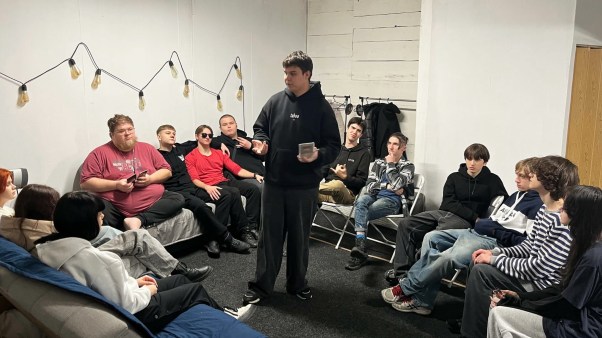My church’s children’s ministry was looking for volunteers one Sunday. “There are scripts and a video you can use, and all materials would be prepped for you,” the email said. “No prep needed.” The lesson plan I received for the story of Shadrach, Meshach, and Abednego in Daniel 3 contained icebreaker questions, Bible passages, and a link to the video teaching. Even the words of a prayer were all written out, ready for me to recite verbatim.
But I decided to formulate my own plan. “Act like a monkey! Sing ‘Baby Shark’ like an opera singer!” I said to my group of fourth and fifth graders at the start of the lesson. Then I asked them, “Have you ever been asked or told to do something that goes against God’s rules?” I told them a story of when I was a child in my karate class in Japan and my teacher asked me to bow down to a shrine. “Even though I was scared to go against the teacher, because I believed in Jesus, I chose not to bow when everyone else in the class bowed their heads.” Upon hearing how my faith was challenged, the kids’ smiling faces expressed surprise and bewilderment.
After some children participated in a trust-fall exercise to experience what having faith in someone else was like, I shared how we should live out our beliefs courageously in obeying God. I then asked them questions like “Do you want to come and play at my house this Sunday instead of going to church?” and “Do you want to play this cool game where we are evil priests who worship other gods?”
Nothing I did was particularly novel or exciting. But the kids in my class were attentive and engaged—surprising my fellow Sunday school teachers, who observed how the children did not display the same level of interest when watching videos about the Bible.
I have taught and led children’s ministry in various American churches for years, and I am alarmed by the growing number of churches that depend on prerecorded videos for Sunday school lessons. This may be partly influenced by a shift toward virtual worship services—children’s ministry included—during the COVID-19 pandemic. Before 2020, almost half of Christian congregations offered online church services, but that figure jumped to three-quarters in 2023. Some megachurches have dedicated YouTube channels for kids’ content featuring animated Bible videos, amassing tens of thousands of views. One video portraying Jesus’ life story has more than 3 million views.
While I am not suggesting a full-scale rejection of the use of screens or technology in church, relying solely on videos during Sunday school seems to convey a poor biblical understanding of the role, function, and process of teaching.
Teaching Scripture through short videos that do not invite social interaction or dialogic thinking shrinks the role of “teacher” into one who is primarily (or only) concerned with communicating Bible knowledge. But Scripture reminds us that being a Bible teacher to little ones is more than simply disseminating facts or truths about the Word. A teacher is to assume an integral role in passing on the faith, exemplifying spiritual maturity, and modeling discipleship to Jesus.
There is certainly a plethora of biblically sound media geared toward kids. Some children’s ministry curricula go through the Bible canonically from beginning to end; others are organized topically. Some, like the BibleProject, offer robust reflections on key portions of Scripture via slick graphics in less than 10 minutes, while others include games and prizes.
Some videos are produced in-house by denominations to ensure theological alignment and supplement Sunday school staff and volunteer efforts. This frees up time spent on lesson preparation and lowers the barrier of entry into children’s ministry. Other videos aim to increase the entertainment value for kids by incorporating corny jokes that supposedly prevent little ones from thinking church is boring.
But there are several glaring disadvantages to depending solely on video content. Kids can disengage cognitively and socially. It’s easy for them to zone out and become passive recipients of information when watching something onscreen since they do not need to actively engage with the content. A video does not invite children to read a passage, prompt follow-up questions, or challenge them to summarize what they’ve learned.
While we seldom see Jesus directly teaching children in the Gospels, they were certainly present during his sermons. In the feeding of the 5,000, the Bible explicitly states that those who ate the bread and fish included men, women, and children (Matt. 14:21). The feeding of the 4,000 similarly identifies children in the crowd (15:38).
In these scenes, Jesus’ role as a teacher is not the focal point of the story. Instead, both stories mention how Jesus saw the crowd and had compassion, which led him to feed the people—children included. However young they might be, the children in these biblical narratives learn about Jesus through their interactions with him. They experience him as giver and provider, one who meets physical needs like hunger with a practical, communal solution. These two narratives affirm that a teacher’s role is not merely about delivering knowledge but also about having tangible, real-life engagement with students.
Jesus is also not content with teaching children from a distance. In a story recorded in all the synoptic Gospels, people bring children and babies for Jesus to lay his hands on and pray over (Matt. 19:13; Mark 10:13; Luke 18:15). When the disciples rebuke the people and try to distance the children from Jesus, he calls the children to himself, lays his hands on them, and blesses them (Mark 10:16). Jesus also instructs his followers, “Let the little children come to me, and do not hinder them, for the kingdom of God belongs to such as these” (Luke 18:16).
This story powerfully demonstrates the importance of how Jesus ministers to children with words and deeds. Children should not simply be a detached audience that listens to Jesus from a distance. Jesus desires to interact directly with them, sharing his love and compassion.
Scripture reveals that a teacher must follow God and exhibit Christ-like attributes to all around them. The apostle Paul critiques “teacher[s] of little children” who teach the law but do not embody what they profess (Rom. 2:17–24). Christian leaders are given leadership roles in the church not simply due to their mastery of knowledge but due to their godly character (1 Tim. 3:1-13).
When children’s ministries increasingly depend on digital content for worship, teaching, and prayer at church, we must ask whether we are helping children experience and follow Christ. While children’s ministry curricula with video content certainly offer convenience and ease, we should not overlook the significant shortcomings churches can experience when they completely depend on videos for Sunday school.
What is the most tangible way we can communicate and show Christ’s love to young hearts and minds in our pews? First John 3:18 says, “Let us not love with words or speech but with actions and in truth.” We can be present with them, pray for them, and be living examples of the love of Christ.
This incarnational model of children’s ministry is challenging and requires a significant time investment. A Sunday school teacher should ideally begin by prayerfully and carefully studying and reflecting on the Scripture passage and what it communicates. Then the teacher can creatively think of ways to help children participate in the learning process.
Instead of using pre-scripted prayers, we can pray out of a genuine love and care for the children in the classroom. We can ask them about their lives and listen attentively to their stories. We can invite children to read Bible verses aloud from a regular Bible rather than a children’s Bible. We can challenge them to think about the “why” behind the stories they read in Scripture. We can cultivate space for them to wonder, imagine, and ask delightfully silly questions.
Some of the most important teachable moments I’ve experienced are unscripted and organic. During our Sunday school lesson on Daniel 3, I asked the children: “If I give you $100, would you say, ‘I hate God’?” One boy jokingly said yes. I paused and responded, “I’m sad to hear this, because we know that in the Bible one of Jesus’ closest followers, named Judas, did this exact thing in turning away from Jesus for money.” The boy looked surprised, probably because he was not expecting me to respond and because what I said made him realize the serious implications of his words.
I don’t know what long-term effect that response had on my Sunday school class, but in that moment, I did something a video-based lesson couldn’t: respond to a spontaneous comment and perhaps help the children see how similar we are to the figures we read about in Scripture.
Kaz Hayashi is associate professor of Old Testament and biblical and theological studies at Bethel University/Seminary and a fellow of Every Voice, an organization that cultivates diversity in Christian theological education.












